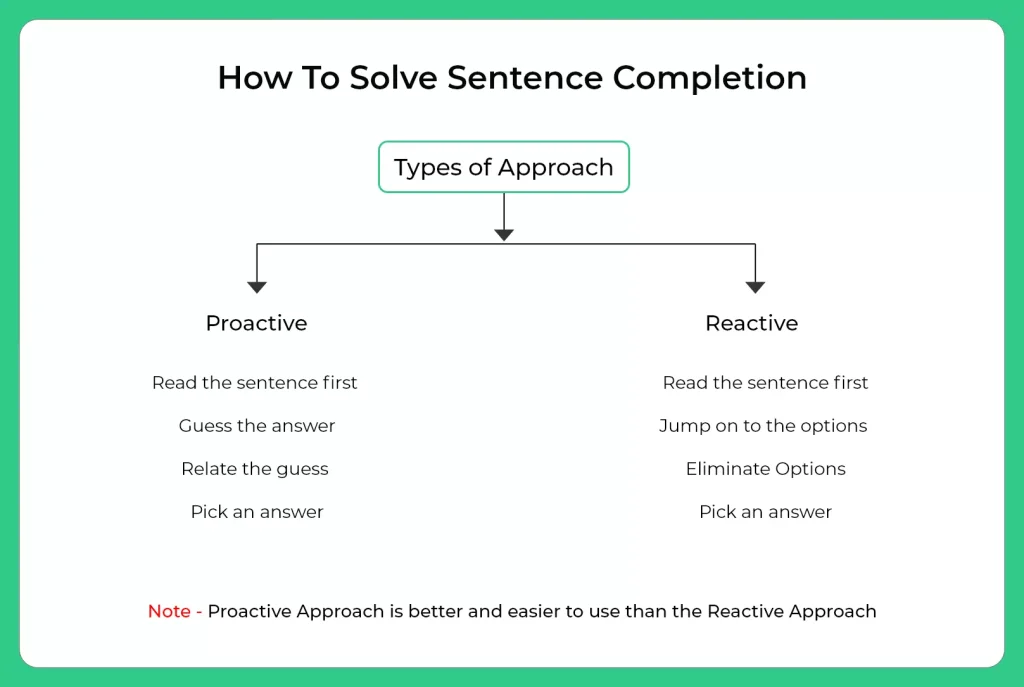Verbal Menu
- Basic Grammar
- Speech and Voices
- Tenses
- Articles
- Tenses and Articles
- Idioms and Phrases
- Subject Verb Agreement
- Prepositions and Conjunction
- Selecting Words
- Relative Pronoun
- Sentence Completion
- Sentence Ordering
- Contextual Vocabulary
- Jumbled Sentence
- Sentence Formation
- Error Identification
- Sentence Improvement and Construction
- Cloze Test
- Fill in the blanks
- Paragraph Ordering
- Para Jumbles
- Synonyms and Antonyms
- Synonyms
- Antonyms
- Reading Comprehension
- Get Off-campus Drive Updates
- Get Hiring Updates
- Contact US
PREPINSTA PRIME
How To Solve Sentence Completion
How To Solve Sentence Completion
In order to understand how to solve sentence completion you first need to know the types of it.
Once that is known to you clearly, you can head over to solving them by using some predefined methods.
Sentence Completion or Word Completion comes under the same broader topic of Sentence Completion in English Grammar. Both of them are in the form of fill in the blank.
The most important thing that you ace in to solve Sentence or Word Completion Questions is Vocabulary. It is all a game of words and if you miss one strike to understand what it means you can go wrong easily.

How To Solve Sentence Completion
Let’s quickly take a review on the types of Sentence Completion and then head over to how To Solve Sentence Completion.
Types based on Word Usage:
- Restatement
- Comparing
- Contrasting
- Cause and Effect
Types based on Format:
- Quantity Based
- Length Based
- Element Based

Let’s now take a look at the methods that we can use to solve Sentence Completion:
Read the Sentence:
Read the sentence thoroughly first and understand the structure. It might seem difficult at first because of the unknown and difficult words but once you break it down and understand the clues, it becomes easy.
Types of Approach:
There are two approaches to understand how to solve sentence completion.
- Proactive
- Reactive
Proactive Approach:
- Read the sentence first and guess what answer can fit in the blank
- Relate the guess with the options given
- Pick the option that resembles closely to your guess
Reactive Approach:
- Reading the sentence / passage first
- Jumping on to the options directly
- Picking an answer
Out of the two approaches, the proactive approach is highly recommended because it makes it easier for the student to guess the answer rather than looking at the options and confusing oneself completely.
Hints:
The hints in a sentence are give to help you understand the word should fit in the blank. Learn how to locate a hint – If you change the hint in a sentence then the choice of the word in the blank also changes.
Word Charge:
Once you get the structure and the hint you can move ahead to see if the sentence needs a positively charged word or a negative one. This can symbolize whether you should go for a synonym or an antonym.
Signpost Words:
Look for signpost words in the sentence that help to determine the required choice of word.
The signpost words which we divide into 2 parts:
- Supporting Signpost
Words that help to relate the two or more clauses in a sentence in the same context.
Example: and, so, hence, therefore, because, thus etc. - Contrasting Signpost
Words that present a contrasting relation between the two or more clauses.
Example: but, despite, though, although, if, or, nevertheless etc.
Root Words:
Root Words are the main words that help us to form a different word in English grammar. Once you know the meaning of these words, it is easy to form new words and also interpret its meaning despite the prefix and suffix used along with it.
Example:
Aqua – means water. Now the words that you can form with it are:
- Aquarium
- Aquatic
- Aquaculture
- Seaquake
Now we know that the root word in all these words is same hence the meaning will be somewhat related to ‘water’.
Know Parts of Speech
Until and unless you know the basics of grammar, that is, the Parts of Speech thoroughly, it can be difficult for you to guess the hints in a sentence. So make an attempt to learn the Grammar Clues as well.
Elimination:
Try to eliminate options only after you have visualized, guessed and applied all possible means to get to an answer. Eliminating options because you don’t know the meaning of it can get you wrong.
Working Backwards:
Try to back track questions if there are two or more words. SO you have a wider chance to eliminate words that don’t fit in either of the blanks and make sense together. So working backwards is often helpful.
Prime Course Trailer
Related Banners
Get PrepInsta Prime & get Access to all 200+ courses offered by PrepInsta in One Subscription
Also Check Out
Also Check:
- Basic Grammar – Questions | Rules | How to Solve Quickly | Tricks & Shortcuts
- Speech and Voices – Questions | Rules | How to Solve Quickly | Tricks & Shortcuts
- Tenses – Questions | Rules | How to Solve Quickly | Tricks & Shortcuts
- Tenses and Articles – Questions | Rules | How to Solve Quickly | Tricks & Shortcuts
- Idioms and Phrases – Questions | Rules | How to Solve Quickly | Tricks & Shortcuts
- Subject Verb Agreement – Questions | Rules | How to Solve Quickly | Tricks & Shortcuts
- Prepositions and Conjunction – Questions | Rules | How to Solve Quickly | Tricks & Shortcuts
- Selecting Words – Questions | Rules | How to Solve Quickly | Tricks & Shortcuts
- Relative Pronoun – Questions | Rules | How to Solve Quickly | Tricks & Shortcuts
- Sentence Completion- Questions | Rules | How to Solve Quickly | Tricks & Shortcuts
- Basic Grammar
Questions
Rules
How to Solve Quickly
Tricks & Shortcuts - Speech and Voices
Questions
Rules
How to Solve Quickly
Tricks & Shortcuts - Tenses
Questions
Rules
How to Solve Quickly
Tricks & Shortcuts - Tenses and Articles
Questions
Rules
How to Solve Quickly
Tricks & Shortcuts - Idioms and Phrases
Questions
Rules
How to Solve Quickly
Tricks & Shortcuts - Subject Verb Agreement
Questions
Rules
How to Solve Quickly
Tricks & Shortcuts - Prepositions and Conjunction
Questions
Rules
How to Solve Quickly
Tricks & Shortcuts - Selecting Words
Questions
Rules
How to Solve Quickly
Tricks & Shortcuts - Relative Pronoun
Questions
Rules
How to Solve Quickly
Tricks & Shortcuts - Sentence Completion
Questions
Rules
How to Solve Quickly
Tricks & Shortcuts
Get over 200+ course One Subscription
Courses like AI/ML, Cloud Computing, Ethical Hacking, C, C++, Java, Python, DSA (All Languages), Competitive Coding (All Languages), TCS, Infosys, Wipro, Amazon, DBMS, SQL and others

 Apply For Jobs
Apply For Jobs Get Hiring Updates
Get Hiring Updates




Login/Signup to comment